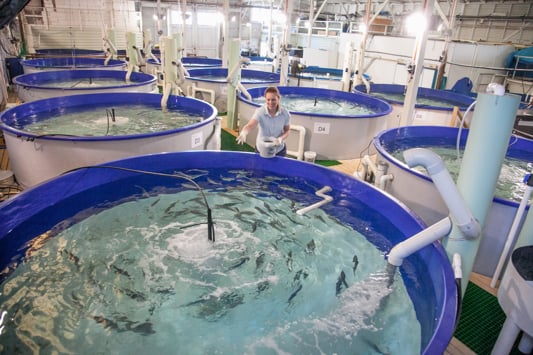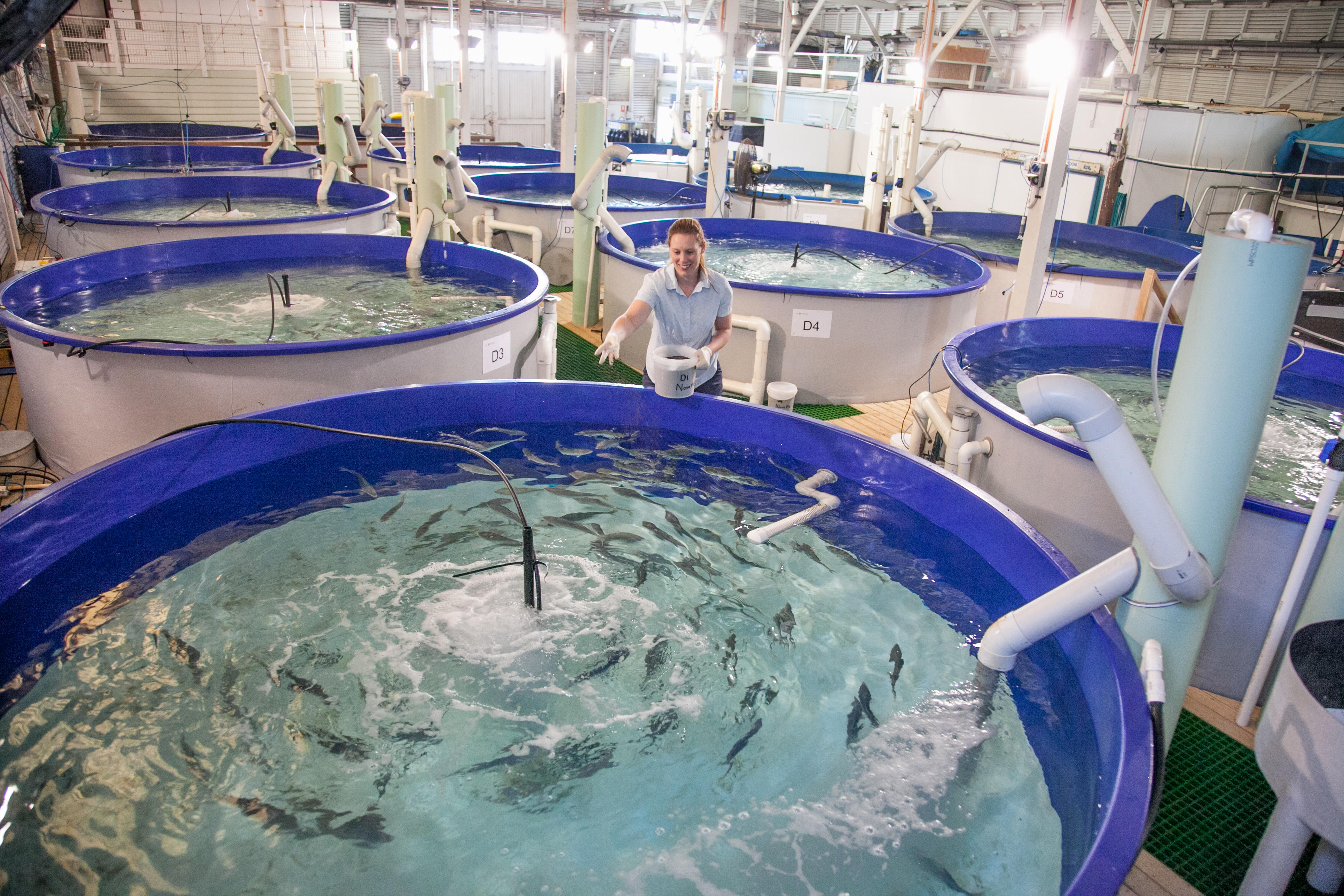
Marine fish production and research
The department conducts research projects and juvenile production to address industry needs and meet current industry requirements, as well as fish stock enhancement programs to restore natural fish resources.
The department's Fremantle Marine Finfish Hatchery is one of the most specialised facilities in the southern hemisphere, with production infrastructure capacity for both flow-through and recirculating aquaculture systems for broodstock husbandry, commercial scale fish culture and dedicated research laboratories.
The hatchery delivers a range of projects aimed at supporting existing growers and driving sustainable industry expansion. Key species produced or supplied by the hatchery include commercial quantities of juvenile yellowtail kingfish (since 2002) and barramundi (since 2010).
Research projects are aimed at meeting current industry needs and addressing any bottlenecks in aquaculture production. The research performed by the hatchery aligns with the states strong focus and investment in developing a viable marine aquaculture industry in WA. The scope of these complex projects cover a variety of research topics:
- disease management
- vaccine development
- nutritional studies in alternative protein sources (including digestibility and their impact on fish health)
- improving fish immunity and health parameters through feed additives
- environmental parameters for optimised growth and feed efficiency.
The hatchery also supports stock enhancement of key species, such as pink snapper, through the production of juveniles to support the WA stock enhancement program.
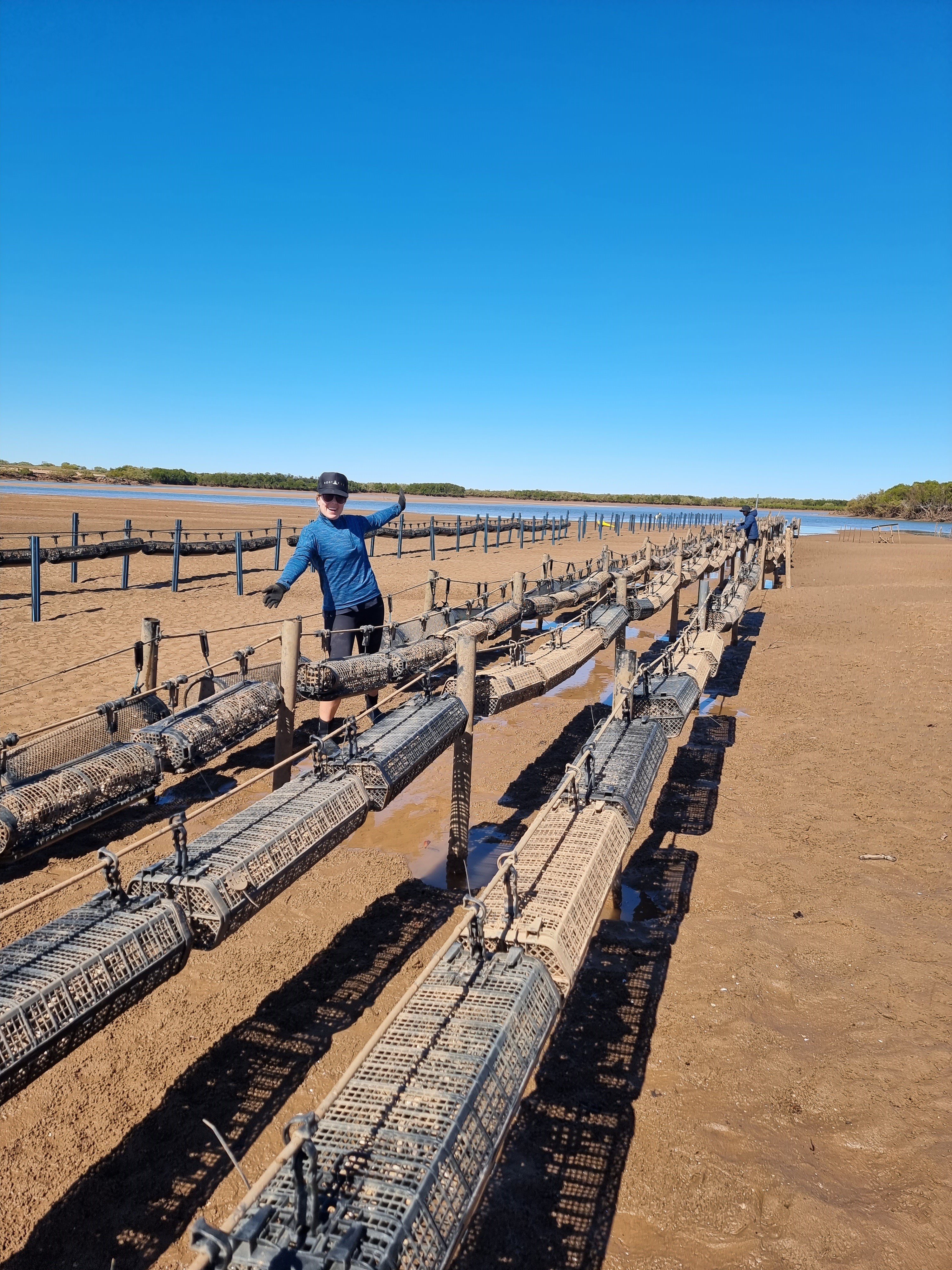
Marine shellfish production and research
The department's marine shellfish aquaculture research team supports shellfish aquaculture in WA. The team undertakes a range of industry-supported projects designed to improve performance, efficiency and sustainability of shellfish farming in WA. This is achieved through the development and introduction of innovative culture systems, techniques, and technology.
The department’s shellfish hatchery at Hillarys conducts research in shellfish breeding, larval culture, and spat production. The hatchery also facilitates aquaculture initiatives by supplying spat endemic to WA. This allows for proof-of-concept and pilot-scale farming trials while also supporting scientific research and development of the hatchery in Albany The hatchery also supports WA’s ocean fisheries by producing shellfish spat for stock enhancement. The departments aim is to improve sustainability and mitigate the negative effects on recruitment arising from climate change and marine heat waves.
The Hillarys Shellfish Hatchery is carrying out a 2-year project on saucer scallop fisheries enhancement. The saucer scallop (Ylistrum balloti) is a difficult species to culture in captivity, especially during larval and early settlement stages, presenting technical challenges for large-scale restocking and stock enhancement initiatives. The project aims to deploy hatchery produced spat into fisheries in WA to increase fishery yields and improve consistency of scallop catches. This project is being implemented by the department with financial and in-kind support from the Fisheries Research and Development Corporation (FRDC) and One Sea Pty Ltd.
The marine shellfish aquaculture research team recently completed a project investigating the feasibility of tropical rock oyster farming in north-west WA. Hatchery produced spat were supplied in the Pilbara and Kimberley regions to assess the potential commercial viability of tropical rock oyster farming. The project was a collaboration with an industry partner and traditional owners Murujuga Aboriginal Corporation, with support from leading oyster farm gear suppliers, and the Cooperative Research Centre for Developing Northern Australia.
The Albany Shellfish Hatchery supplies seed (spat) of rock oysters, blacklip pearl oysters, Akoya, and mussels for commercial grow-out (farming) operations in WA. Albany Shellfish Hatchery has enabled significant expansion of shellfish aquaculture, particularly around Albany, facilitating the creation of over 25 direct jobs in regional WA. The state has contracted a highly experienced hatchery operator to run the Albany Shellfish Hatchery, with department oversight of the operation through an Advisory Committee.
A floating upwelling system (FLUPSY) is a floating, sea-based nursery for shellfish spat which allows high-density stocking. Shellfish spat grown inside mesh pots feed on naturally available food that is pumped into the holding vessels along with sea water. This creates a sustainable and efficient nursery environment, reducing power and pumping costs through the low-head design. One of Australia’s first large-scale FLUPSYs has been trialled in Albany - a collaboration between DPIRD and industry partners.
The department’s shellfish aquaculture research staff provided design input and expertise, building the technology to industry requirements and testing operational performance on an oyster farming lease in Albany.
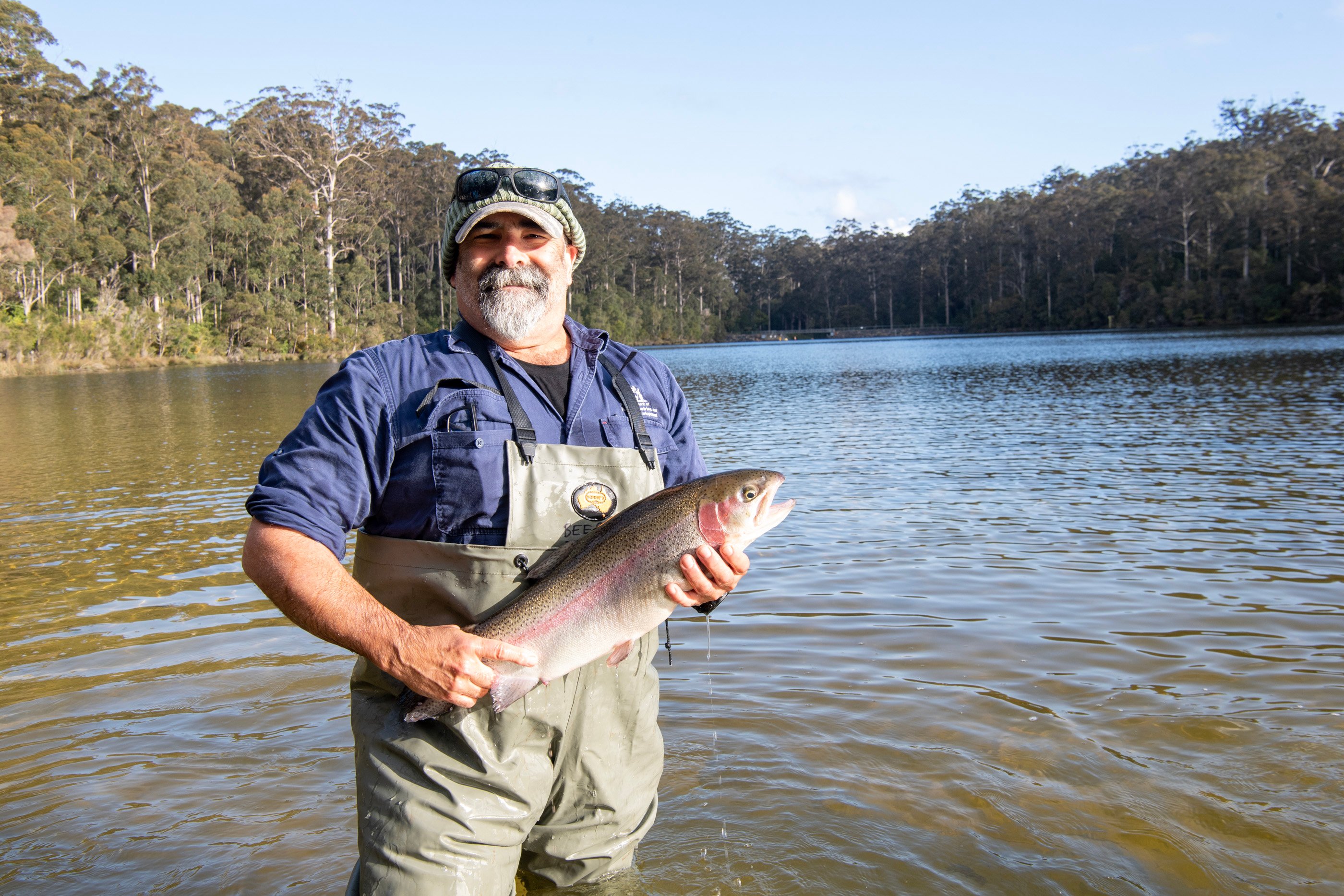
Freshwater aquaculture production and research
The department undertakes research and production of key species, including trout and marron, to support freshwater aquaculture development and recreational fishing through trout stocking. Freshwater fish aquaculture in WA includes production of ornamentals, rainbow trout, barramundi, Murray cod and silver perch; however, trout is the largest and longest established finfish aquaculture industry in the state.
To enable industry growth, the department builds strong relationships with key growers and industry representative in conjunction with collaborative research. Trout bred in captivity by the department are the foundation of recreational freshwater fishing in WA.
The department has operated the trout hatchery at the Pemberton Freshwater Research Centre for over 50 years. The hatchery is the foundation for the ‘put and take’ rainbow trout and brown trout fishery across the south-west of WA. The fishery is enjoyed by around 10,000 licensed anglers each year and contributes an estimated $37 million of value annually to the south-west regional economy.
From 2023, the Pemberton Freshwater Research Centre anticipates production of around 100,000 fry, growing out at least 30,000 rainbow trout and 12,000 brown trout yearlings, and releasing over 2500 ex-broodstock that are the foundation of this successful and sustainable recreational fishery.
Aquaculture businesses grow out more than 75,000 fry per year and these fish are consumed in Perth restaurants or exported to premium Asian markets. WA rainbow trout is a premium food product, and value adding of trout egg caviar and whole smoked fish are gourmet offerings from the southern forest region. Private landowners enjoy stocking the dams and lakes on their properties with trout and the Pemberton Freshwater Research Centre sells 75,000 to 100,000 fry each year for this purpose.
Marron (Cherax cainii) is an iconic species in WA, synonymous with the forest lined rivers and dams of the south-west. While marron production has fluctuated between 50-60 tonnes over the last two decades, marron farming continued to contribute over $2 million to the state’s economy in 2021-22.
Increasing production of marron faces common challenges however, such as:
- marron are typically grown in small volumes
- lack of suitable sites for marron aquaculture
- water availability and security
- cost of suitable land
- cost of supporting infrastructure (predator netting and fencing)
- reduced rainfall
- competition with other land-uses
- competition with pest species
- predation.
As the third largest freshwater crayfish in Australia, and a species endemic to WA, marron aquaculture presents WA with an opportunity to develop a high-quality, gourmet product suitable for an international market.
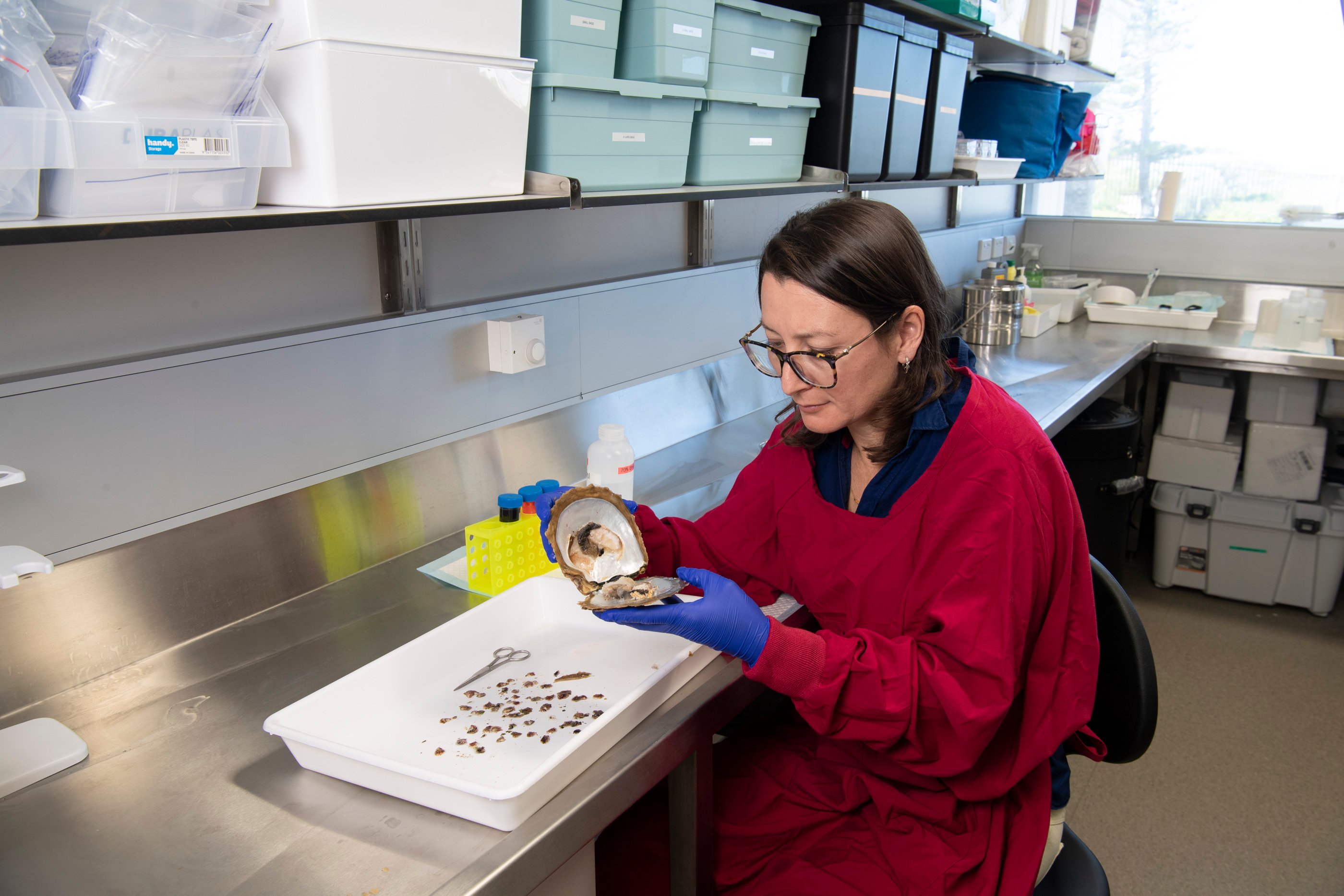
Aquatic animal health research
The department has a dedicated aquaculture health team to provide research services and specialist advice, and support the development of WA's aquaculture and seafood industries.
The Aquatic Animal Health Research Laboratory is located at the Indian Ocean Marine Research Centre facility in Watermans Bay. The location allows close collaboration on applied research projects focused on supporting expansion of the WA seafood Industry. The team works closely with partners including The University of Western Australia, CSIRO, and the Australian Institute of Marine Science.
The aquatic health team develops applied research projects aligned with the needs of the seafood industry. This often involves controlled experimental conditions to study the development of a disease or the response of animals to stressors and pathogens.
The team currently leads research projects on abalone and pearl oyster health. These projects focus on improving the productivity of the abalone and pearling industries in WA.
More information on current and completed aquaculture health research projects is provided by the Fisheries Research and Development Corporation.
Contact us
-
Aquaculture Research & Development

